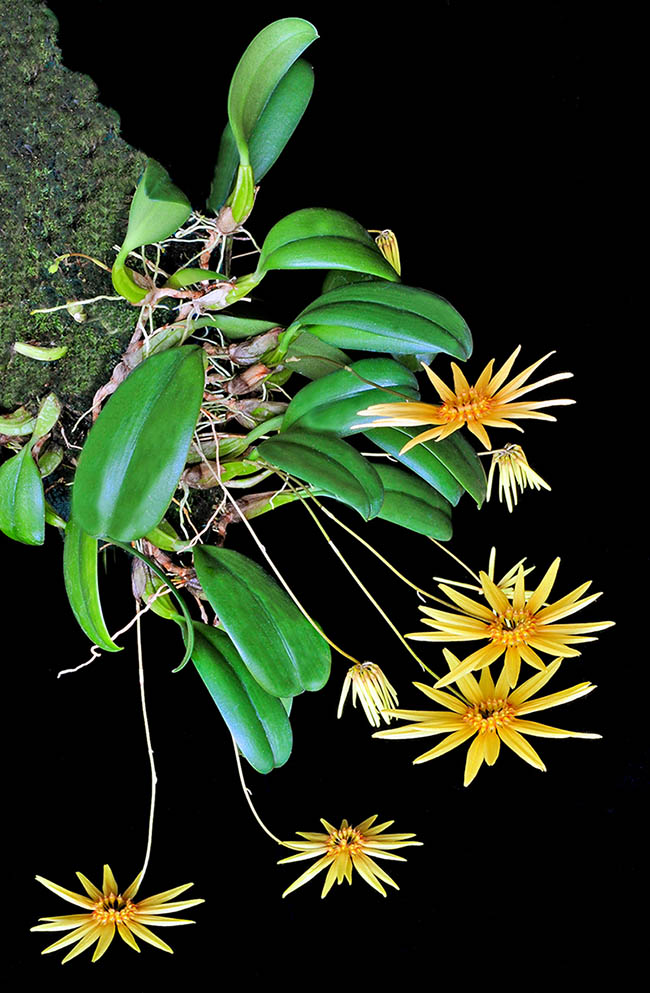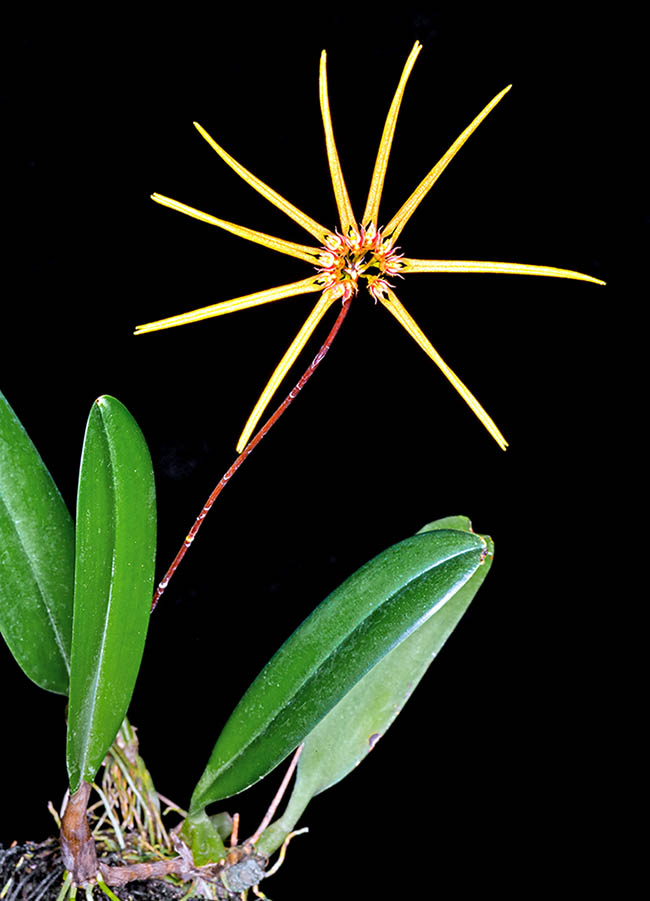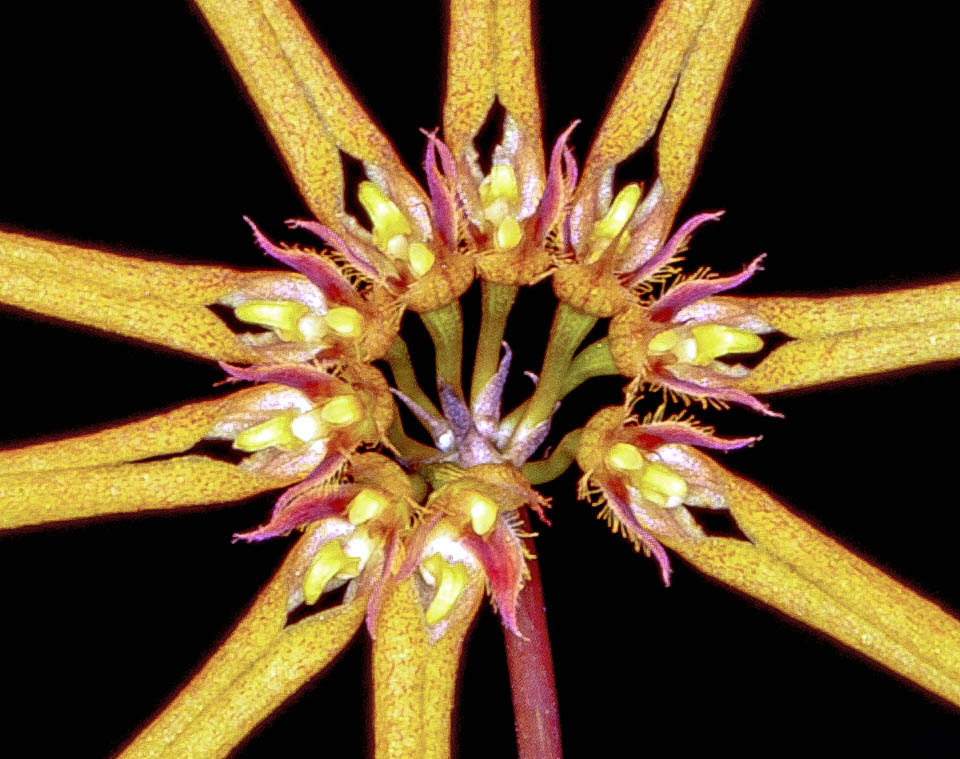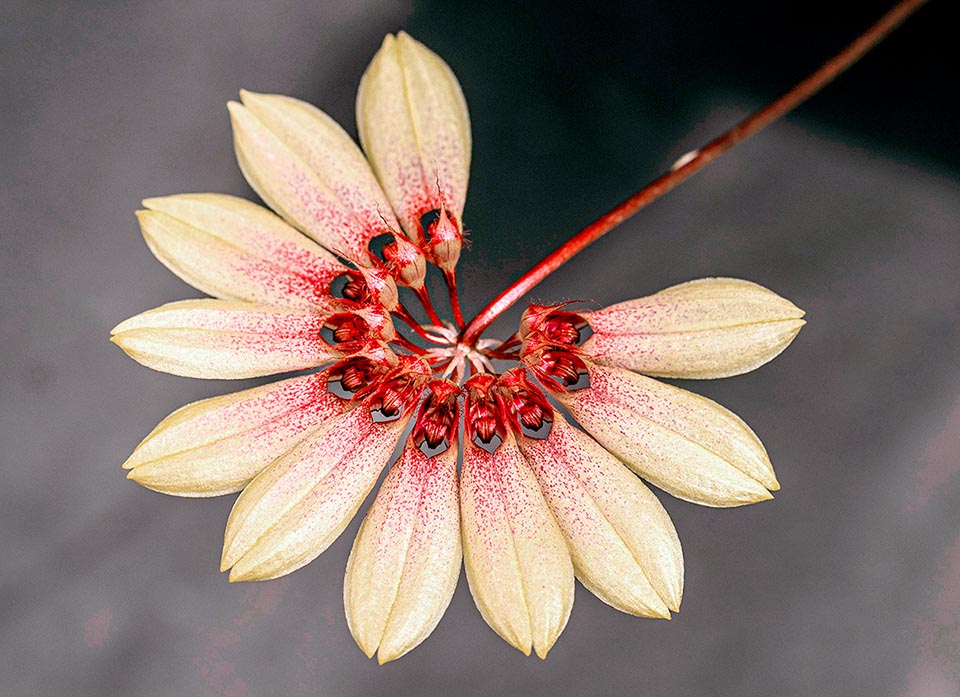Family : Orchidaceae

Text © Prof. Pietro Pavone

English translation by Mario Beltramini

With its daisy-like inflorescences, for attracting also the pollinators of the Asteraceae, Bulbophyllum makoyanum is an only 8 cm high epiphyte. Filiform roots and a thin rhizome carrying oval 2 cm pseudobulbs © Peter Tremain
Bulbophyllum makoyanum (Rchb.f.) Ridl. belongs to the family of the Orchidaceae, subfamily
Epidendroideae, recently included in the subtribe Dendrobiinae, tribe Malaxideae.
It is a species endemic to the Philippines, Borneo, Malaysia and Singapore.
In the Philippines it grows on the trees, at low altitude, in the island of Mindanao, in the island of Busuanga, in the island of Luzon and in the islands of Palawan and Polillo.
In Borneo it is found in the plain forests of the Kalimantan at altitudes from 100 to 200 (300) m.
The name of the genus Bulbophyllum comes from the combination from the Greek “βολβός” (bolbos) that means ‘bulb’ and “φύλλον” (phyllon), ‘leaf’, referring to the pseudobulbs with only one leaf of which the plant is equipped.
The specific epithet is honoured to the Belgian botanist Lambert Jacob-Makoy (1790-1873) who furnished the first specimen of this species to his German colleague Heinrich Gustav Reichenbach (1823-1889) who, in 1879, described it as Cirrhopetalum makoyanum Rchb.f., but Henry Nicholas Ridley (1855-1956), in 1907, has reclassified it includingn it in the genus Bulbophyllum.
It is commonly known as “Makoy’s Cirrhopetalum” and also as “Daisy Orchid”, due to the shape of the open inflorescence reminding the capitulum of a daisy.
Bulbophyllum makoyanum is a commercially protected species because it is at risk of extinction in nature and as such inscribed in the appendix II of Washington Convention (CITES) that has the aim of protecting the animal and plant species at risk of extinction, preventing their export and detention.
It is a perennial, sympodial epiphyte, very small that reaches the height of 8 cm with filiform roots suitable for creeping on the surface of the trees with a thin rhizome from which, spaced of about 2 cm one from the other, forms pseudobulbs, partially covered by quite adherent sheaths. Each pseudobulb, smooth when young and grooved with age, is about 2 cm long. It has an oval shape and has only one leaf. The leaves, shaped like a tongue, are 7 cm long and 2 cm broad, slightly sectioned at the apex and narrow at the base forming a short petiole.
From the base of the youngest mature pseudobulb takes form the inflorescence, up to 20 cm long, with an erect violet axis. The 5 to 10 flowers are scented and arranged at the top in an umbel, typically racemose inflorescence shaped like a fan or an umbrella.

The pseudobulbs have only one 7 cm long leaf. The inflorescence may reach 20 cm and from the centre radiate the lateral sepals of the flowers, very long and at times strictly linear, of a pale yellow spotted violet at the base © Giuseppe Mazza
This arrangement of the flowers, according to some researchers, is the imitation of inflorescences of plants that offer nectar, like, for instance, the capitulum of the Asteraceae, even if has not yet been proved the coexistence of these orchids with autochthonous membres of this family present in the same habitat. The hypothesis is based on a strategy very used by the orchids: the deception.
From the centre of the inflorescence radiate the lateral sepals that are elongated and strictly linear, of pale yellow colour, covered by small violet dots towards the centre of the inflorescence. They are longer than the other parts of the flower (about 3,7 cm) and are connected to each other at the edges almost for all their length. The superior sepal is reddish with darker spots and stripes with about 1 mm long hairs on the margins. The petals are similar in colour and shape to the sepals.
The column is robust and has a geniculate foot, to which is stuck the labellum, in order to make it mobile and oscillating with every breath of wind for attracting the pollinating insects. It is fleshy and smooth, 0,25 cm long, shaped like a tongue, of yellowish colour and with a reddish border.
The pedicel and the ovary are both 0,6 cm long. In the Philippines, blooming happens in the months of February and March and from September to December.
The beauty of the flowers of this orchid has led many lovers to cultivate it at home as well as in the greenhouse.
It is a thermophilic plant. Therefore, it requires temperatures from intermediate to warm. In fact, in the origin countries, during the whole year, the average diurnal temperature is of 29-32 °C and the night medium temperature is of 22-24 °C with a daily amplitude of 7-9 °C. The humidity varies from 85 to 90% for most of the year and decreases up to about 80% by the end of winter and early spring.
In cultivation, the plants are not to be exposed to the direct sunlight, especially during the hours of maximum sunshine, but require light that will have to be of about 12000-20000 lux, that is, partially filtered and diffused light.
During the growing time, the plants must be watered copiously, but it is necessary to ensure to the substratum a good drainage as this must never be too soaked. An air movement is appropriate around the roots and for this purpose is good to utilize very flat pots or baskets with a very loose substratum that may rapidly dry up avoiding the growth of fungi. As the plant does not tolerate close repottings, are to be preferred fibres of arboreal ferns that are more lasting than those of bark of pine.

The scented flowers, 5 to 10 umbrella arranged, have petals and upper sepal of reddish colour. The labellum is oscillating, similar to a small yellow tongue © Giuseppe Mazza
When the substratum is completely decomposed and the plants need to be repotted it is a good practice to wait for the birth of the new roots in order to allow the plant to take root as fast as possible.
The plants should be fertilized every week with 1/4-1/2 the recommended dosage of fertilizer for orchids. In spring and midsummer can be utilized a nitrogen-rich fertilizer, whilst in late summer and in autumn it can be richer in phosphorus. In winter the quantity of water must be reduced as well as the fertilization.
Several hybrids have been obtained from this species. For instance, the primary hybrid Bulbophyllum Daisy Chain was obtained by crossing between Bulbophyllum makoyanum × Bulbophyllum cummingii (Lindl.) Rchb.f. and was registered by Stewart Inc. on 01/01/1969. It is an attractive plant even when not in flower, easy to cultivate.

Protected in the wild, this species has generated in culture various hybrids. Here Bulbophyllum ‘Daisy Chain’ from Bulbophyllum makoyanum x Bulbophyllum cummingii © Bill Galli
It grows quickly until flowering which occurs from late winter to early summer characterized by a high increase of light pink flowers, arranged in small umbels.
The crossing between Bulbophyllum Daisy Chain × Bulbophyllum purpurascens Teijsm. & Binn. has produced the hybrid Bulbophyllum Daisy Chain × purpurascens, registered by Wingarden & Home in 2018. The inflorescence, formed by 14 delicately scented yellow flowers, looks a lot like a “daisy”.
Synonyms: Cirrhopetalum makoyanum Rchb. F. 1879.
